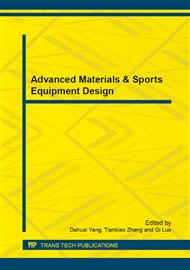[1]
S. Nakamura, G. Fasol: The Blue Laser Diode, Springer-Verlag, Berlin, Germany, (1997).
Google Scholar
[2]
S. Nakamura: Semicond. Sci. Technol. 14 (1999)p. R27–R40.
Google Scholar
[3]
T. Asano, M. Takeya, T. Mizuno, S. Ikeda, Y. Ohfuji, T. Fujimoto, K. Oikawa, S. Goto, T. Hashizu, K. Aga and M. Ikeda: Proc. SPIE 5365 (2004)p.297–305.
DOI: 10.1117/12.533187
Google Scholar
[4]
F. Bernadini, V. Fiorentini, D. Vanderbilt: Phys. Rev. B 56 (1997) 10024.
Google Scholar
[5]
M. -F. Huang, T. -H. Lu: IEEE J. Quantum Electron. 42 (2006) p.820–826.
Google Scholar
[6]
L.H. Peng, C.W. Chuang, L.H. Lou: Appl. Phys. Lett. 74 (1999)p.795–797.
Google Scholar
[7]
S. Chichibu, T. Azuhata, T. Sota and S. Nakamura: Appl. Phys. Lett. 69 (1996) p.4188–4190.
DOI: 10.1063/1.116981
Google Scholar
[8]
Y. Arakawa, A. Yariv: IEEE J Quan-tum Electron. 22 (1986)p.1887–1898.
Google Scholar
[9]
G. Franssen, T. Suski, P. Perlin, R. Bohdan, A. Bercha, W. Trzeciaskowski, I. Makarowa, P. Prystawko, M. Leszczynski, I. Grzegory, S. Porowski and S. Kokennyesi: Appl. Phys. Lett. 87 (2005) p.41109–41111.
DOI: 10.1063/1.2000331
Google Scholar
[10]
M.D. Craven, S.H. Lim, F. Wu, J.S. speck and S.P. DenBaars: Appl. Phys. Lett. 81 (2002)p.469.
Google Scholar
[11]
X. Ni, Ü. Özgür, A.A. Baski, H. Morkoc¸ , L. Zhou, D.J. Smith and C.A. Tran: Appl. Phys. Lett. 90 (2007) 182109.
Google Scholar
[12]
J. Zhang, J. Yang, G. Simin, M. Shatalov, M.A. Khan, M.S. Shur and R. Gaska: Appl. Phys. Lett. 77 (2000) p.2668–2670.
DOI: 10.1063/1.1319531
Google Scholar
[13]
J. -R. Chen, C. -H. Lee, T. -S. Ko, Y. -A. Chang, T. -C. Lu, H. -C. Kuo, Y. -K. Kuo, S. -C. Wang: J. Lightwave Technol. 26 (2008) p.329–337.
Google Scholar
[14]
ISE TCAD User's Manual Release 10. 0, Zurich, Switzerland, (2004).
Google Scholar
[15]
S.L. Chuang, C.S. Chang: Phys. Rev. B 54 (1996) p.2491–2504.
Google Scholar
[16]
H.Y. Zhang, X.H. He, Y.H. Shih, M. Schurman, Z.C. Feng R. and A. Stall, Opt. Lett. 21 (1996) p.1529–1531.
Google Scholar
[17]
Y. -K. Kuo, Y. -A. Chang: IEEE J. Quantum Electron. 40 (2004)p.437–444.
Google Scholar
[18]
V. Fiorentini, F. Bernardini, O. Ambacher: Appl. Phys. Lett. 80 (2002)p.1204–1206.
Google Scholar
[19]
D. Fritsch, H. Schmidt, M. Grundmann: Phys. Rev. B 67 (2003) 235205.
Google Scholar
[20]
E. Michael, Levinshtein, L. Sergey, Rumyantsev and Michael S. Shur: Properties of Advanced Semiconductor Materials, John Wiley & Sons, Toronto, Canada, (2001).
Google Scholar
[21]
F. Bernardini, V. Fiorentini: Phys. Rev. B 64 (2001) 085207.
Google Scholar


